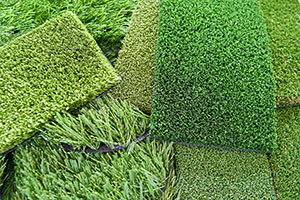Why would anyone replace a key sustainable component of our living environment with a coal and oil-derived product, one of only limited life span and almost impossible to recycle? When the entire planet is waging war on unnecessary plastics and the climate emergency, what is it that persuades consumers to make this terrible choice? And why cover children’s sports fields in products that can harm their health? Why on earth does anyone choose artificial grass? And why does the Government do nothing about it?
The reason is threefold: 1) skilful marketing, 2) the absence of product and consumer information, and 3) the lack of industry and product regulation. It doesn’t matter where your priorities lie, from saving the planet to saving your pennies; seen from any angle this is clearly a scandal. So, before it is too late, we must dig deeper and expose the murky truths behind this phenomenon - and help stem a slowly emerging environmental disaster. Let’s address the three areas of blame, in turn, starting with marketing, a brilliant lesson in consumer exploitation – and an opportunity to debunk some untruths.
How do you market an unsustainable product and promote the destruction of the living environment? You do it by being economic with your information. People want convenience, and so that’s how the industry sells it. “Why not replace the chore of lawn care with a maintenance-free alternative?” they ask. People want to be responsible too, so they also ask: “And why not help save the planet by getting rid of your petrol mower?” But translate this into straight-talking and you get: “Why not replace nature’s lungs with a petro-chemical product that damages rather than helps the environment, a product that does indeed require maintenance and will need replacing every ten years or so?” And remember, there’s only one recycling centre that, in theory, can deal with this stuff – and it’s in Denmark and is not currently operable!
Of course, if it was called by the accurate name, plastic grass, sales would plummet. And if buyers saw the growing mountains of worn-out artificial grass accumulating in landfill around the world, they would certainly hesitate. So, these topics are carefully avoided. And you cannot miss the irony of their “environmental” message; just like petrol, plastic grass is an end product of the coal and oil industry, using plastics such as polyethylene, polypropylene and nylon. So, whether selling plastic grass or a tank of petrol, it’s all good business for the industries profiting from fossil fuels.
Promoters of artificial grass even say that it is ‘maintenance-free’. This is simply not true unless you are  happy to have a growing build-up of excrement and urine from birds, dogs, mice, etc not to mention self-seeding grasses and weeds. And your artificial grass will certainly need cleaning, and as you hose it down (using more water than is necessary to keep a real lawn alive), think of the chemical cocktail leaching into the ground. And get this; you may also need to treat your artificial grass against moss! So much for maintenance-free.
happy to have a growing build-up of excrement and urine from birds, dogs, mice, etc not to mention self-seeding grasses and weeds. And your artificial grass will certainly need cleaning, and as you hose it down (using more water than is necessary to keep a real lawn alive), think of the chemical cocktail leaching into the ground. And get this; you may also need to treat your artificial grass against moss! So much for maintenance-free.
Consumer information: Consumers today want information – but paradoxically this can make them more ready to believe what they are told, whatever the source. And sadly only a few relevant facts ever appear in marketing or even horticultural texts. To address the lack of consumer information, here are just a few quickfire facts about plastic vs real grass:
• Real grass captures CO2. Plastic grass generates colossal CO2 in its manufacture.
• Real grass cools the surrounding areas. Plastic grass heats up in hot weather to intolerable temperatures, especially for small children and pets
• Real grass can survive even a summer drought without watering. Plastic grass requires regular hosing down.
• Real grass lawns last for many decades! Plastic grass wears out after a few years.
• Real grass sustains biodiversity. Plastic grass creates no-go zones for wildlife.
Complete information is not just essential, but a consumer right. However, the statement below is from a typical UK artificial grass supplier’s website and the only environment-related comment: “Plus, there’s no watering or feeding required so it’s kinder to the environment.” Incomplete and misleading, it shows how far the industry falls below this standard:
There is an even more serious topic that is carefully avoided in marketing or related information about plastic grass – the risk it poses to our health.
How artificial grass damages your health
Alongside rising temperatures, the next most serious crisis we battle is air quality. A living grass lawn absorbs pollutants and CO2 from the air and, like any plant, exudes breathable oxygen. Replacing it with artificial grass simply removes this natural – and essential – contributor to our health.
What about humidity? Given the choice, would you rather spend a few summer hours with some natural moisture rising from your feet or baking from the dry heat reflected and generated by the plastics? Your lungs will tell you soon enough if you’re not sure.
Worst of all is a very sinister danger that still does not receive a fraction of the attention it deserves – the use of crumb rubber to dress artificial sports turf (the same toxic material that all our children are playing on at schools). The idea is that it helps keep the fake grass upright and cushions the blows when you fall. But there are stories of children suffering major health issues from the effects of inhaling this noxious substance made from old car tyres. Yet unsuspecting parents, trusting their local authorities, schools or sports clubs, allow their children to play on this, unaware that the grains caught in clothing and inhaled during play can be extremely dangerous.
All in all, there is very little to condone the use of artificial grass. It was one of those ‘great ideas’ when still at the drawing board, a very profitable convenience solution for our modern times. But now you can see why it should never have left the drawing board. Yet it has, and people are buying it in growing numbers. So what is to be done about it?
We need a remedy based on two parallel lines - conversation and education. The big question is how that conversation and education can be safeguarded from further untruths and manipulations. I have some suggestions.
Industry regulation: It’s obvious. Whenever an industry is found to be falling short of good practice in one way or another or to be promoting something known to be a threat to health and well-being, some form of regulation is introduced. It might be led from within or imposed eternally; what matters is that we, the consumers, can trust what we are told and make properly-informed choices.
Horticultural sector: One huge puzzle is why gardeners have not rallied against this. Responsible gardeners and indeed land managers would no more replace living trees (another vital eco-lung) with plastic imitations than we would replace our herbaceous borders with plastic ones. So why grass? Why is the sector so quiet on this topic?
The scientific community: Research is already underway to evaluate plastic grass for environmental and health risks. But we also need the flip side concerning living grass, the scientifically-robust facts and figures about its environmental benefits or the net carbon footprint (grass as a carbon sink versus the carbon cost of proper lawn care).
And what about the Government doing nothing? To be fair, they’ve been busy with other things but that can no longer be an excuse. And if we look back with regret in 20 years’ time it will be we who share the blame. This is a huge problem that has crept up and will only get worse unless a real and urgent change takes place. So it must go to the top of Government and its agenda for health, sustainability and the environment. To date, a few thousand of those in the know have added their signatures to my petition – but we need hundreds of, not tens of, thousands to sign – and that’s still only a fraction of the Nation of Garden Lovers we claim to be.
We need the full story to get out there, and we need it fast. Without this, we cannot blame the consumer for choosing something that actually destroys the very ecosystem that helps provide a natural solution to the climate emergency.
www.davidhedges-gower.com


 happy to have a growing build-up of excrement and urine from birds, dogs, mice, etc not to mention self-seeding grasses and weeds. And your artificial grass will certainly need cleaning, and as you hose it down (using more water than is necessary to keep a real lawn alive), think of the chemical cocktail leaching into the ground. And get this; you may also need to treat your artificial grass against moss! So much for maintenance-free.
happy to have a growing build-up of excrement and urine from birds, dogs, mice, etc not to mention self-seeding grasses and weeds. And your artificial grass will certainly need cleaning, and as you hose it down (using more water than is necessary to keep a real lawn alive), think of the chemical cocktail leaching into the ground. And get this; you may also need to treat your artificial grass against moss! So much for maintenance-free.